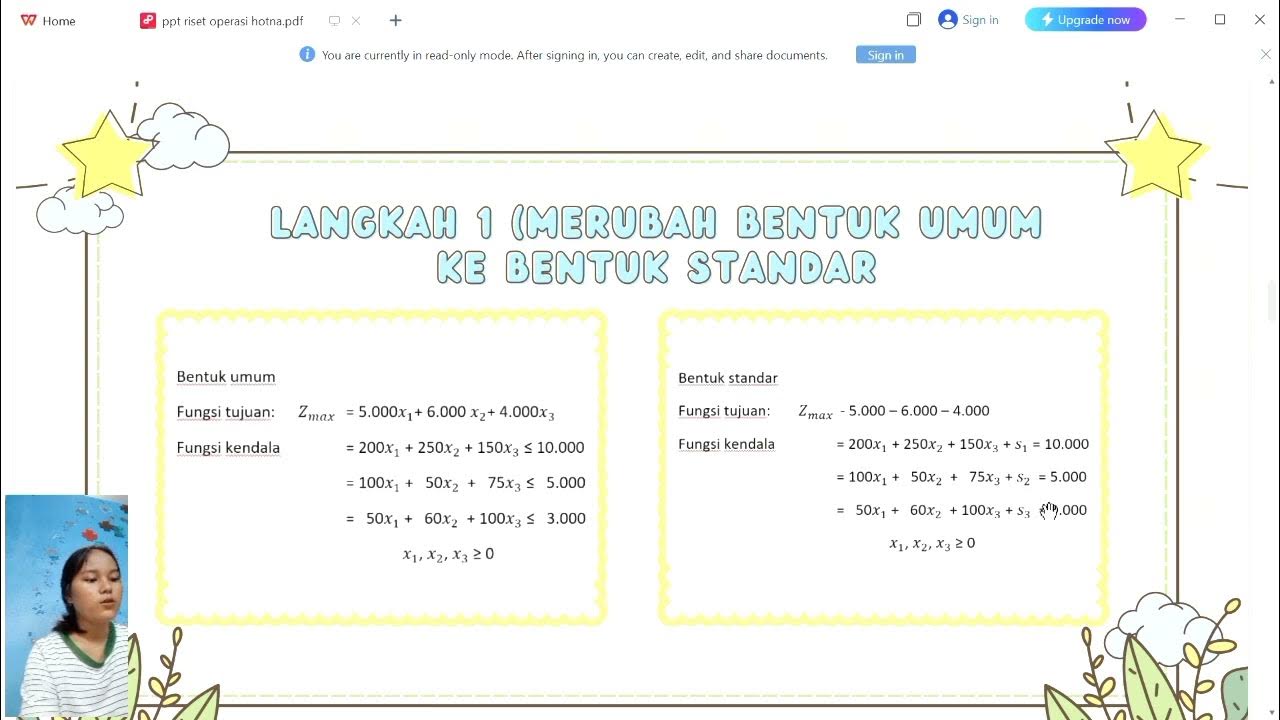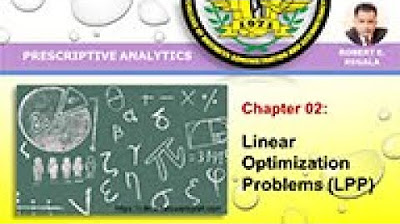Pertidaksamaan Linear Satu Variabel | Sistem Persamaan Linear | MANTUL | Matematika | SMP | Seg.2
Summary
TLDRIn this video, the narrator uses a practical scenario to explain how to solve a linear inequality problem. Two workers are tasked with delivering 100 heavy boxes, each weighing 20 kg, using a truck with a capacity of 835 kg. By setting up and solving a linear inequality, the narrator demonstrates that in one trip, the truck can carry a maximum of 36 boxes, meaning the workers need to make three trips. The explanation showcases how real-world problems can be tackled using basic algebraic concepts like linear inequalities, making math accessible and relevant.
Takeaways
- 😀 The script starts with casual dialogue about logistics, where the speaker discusses delivering heavy boxes and a vehicle's weight capacity.
- 😀 The conversation shifts to a mathematical problem involving linear inequalities to determine how many trips are needed for a delivery.
- 😀 The weight of each box is 20 kg, and two workers, with weights of 62 kg and 53 kg, must be factored into the vehicle's total load capacity of 835 kg.
- 😀 The speaker introduces the concept of linear inequalities, explaining that such problems often involve determining solutions for one variable.
- 😀 The inequality for the problem is represented as 20a + 115 ≤ 835, where 'a' is the number of boxes the vehicle can carry in one trip.
- 😀 The solution to the inequality gives a maximum of 36 boxes that can be carried in a single trip, factoring in the workers' weights.
- 😀 The next step is to calculate the number of trips required to deliver all 100 boxes, which is done by dividing the total boxes by the capacity per trip.
- 😀 The final calculation shows that 100 ÷ 36 = 2.78, which rounds up to 3 trips required to deliver all the boxes.
- 😀 The speaker emphasizes the importance of understanding the properties of inequalities, especially how they change when dividing or multiplying by negative numbers.
- 😀 The problem is framed in the context of real-world logistics, showing how mathematical concepts like linear inequalities can solve practical challenges like delivery planning.
Q & A
What is the main mathematical concept discussed in the script?
-The main mathematical concept discussed is linear inequality, specifically linear inequalities with one variable. The script uses this concept to calculate how many trips are needed to transport boxes using a vehicle with a weight limit.
How are the boxes' weight and the workers' weight factored into the calculation?
-The weight of each box (20 kg) is multiplied by the number of boxes being transported. Additionally, the combined weight of the two workers (62 kg and 53 kg) is added to the total weight in each trip. The total weight must be less than or equal to the vehicle's weight capacity (835 kg).
What was the capacity of the vehicle used for transporting the boxes?
-The vehicle used for transporting the boxes has a weight capacity of 835 kg.
What is the inequality equation set up to calculate the number of boxes that can be carried in one trip?
-The inequality equation set up is: 20A + 62 + 53 ≤ 835, where A represents the number of boxes being transported. The sum of the boxes' weight and the workers' weight must not exceed the vehicle's capacity.
How was the number of boxes (A) per trip determined?
-The inequality 20A + 115 ≤ 835 was simplified to 20A ≤ 720, and then divided by 20 to find A ≤ 36. This means that a maximum of 36 boxes can be transported in one trip.
How many trips are needed to deliver all 100 boxes?
-To deliver all 100 boxes, 3 trips are needed. Since each trip can carry 36 boxes, dividing 100 by 36 gives 2.7, which is rounded up to 3 trips.
What does the script suggest about the mathematical method used to solve this problem?
-The script suggests that mathematics, specifically linear inequalities, helps solve real-world problems like logistics by simplifying complex scenarios and providing clear solutions.
What role does the workers' weight play in the problem?
-The workers' weight is factored into the total weight that the vehicle is carrying. The combined weight of the two workers (115 kg) must be included in the total weight calculation for each trip to ensure it does not exceed the vehicle's capacity.
Why is it important to account for both the weight of the boxes and the workers?
-It is important to account for both the boxes' weight and the workers' weight because the total weight being transported in the vehicle cannot exceed its weight capacity. Any excess weight would make it impossible to carry the load safely.
What happens when the workers have to carry more boxes than their vehicle's capacity allows in one trip?
-If the workers attempt to carry more boxes than the vehicle's capacity allows, they would need to make multiple trips to ensure that the total weight per trip does not exceed the vehicle's weight limit. In this case, 3 trips are required to deliver all 100 boxes.
Outlines

This section is available to paid users only. Please upgrade to access this part.
Upgrade NowMindmap

This section is available to paid users only. Please upgrade to access this part.
Upgrade NowKeywords

This section is available to paid users only. Please upgrade to access this part.
Upgrade NowHighlights

This section is available to paid users only. Please upgrade to access this part.
Upgrade NowTranscripts

This section is available to paid users only. Please upgrade to access this part.
Upgrade Now5.0 / 5 (0 votes)





